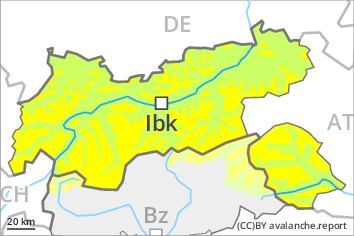
Danger level
 | 2000m |
|  |
|  |

Weakly bonded old snow is to be evaluated with care and prudence. As a consequence of warming during the day and the solar radiation, the likelihood of moist snow slides during the day being released will increase on extremely steep south facing slopes.
Weak layers in the old snowpack can still be released in some places by individual winter sport participants. The avalanche prone locations are rather rare but are barely recognisable, even to the trained eye. They are to be found in particular on steep shady slopes above approximately 2000 m and on steep sunny slopes above approximately 2200 m. Caution is to be exercised at transitions from a shallow to a deep snowpack, when entering gullies and bowls for example, as well as in little used terrain.
Avalanches can penetrate deep layers and reach large size in isolated cases in the regions with a lot of snow.
The small wind slabs of the weekend can still be released in some cases in particular on very steep shady slopes in high Alpine regions.
On extremely steep south facing slopes individual moist snow slides are possible as a consequence of warming during the day and solar radiation.
Meticulous route selection is advisable.
Snowpack
dp.1: deep persistent weak layer
dp.7: snow-poor zones in snow-rich surrounding
Faceted weak layers exist in the old snowpack, especially on shady slopes above approximately 2000 m, as well as on sunny slopes above approximately 2200 m.
Stability tests and field observations confirm that the stability of the snowpack varies greatly within a small area.
The small wind slabs of the last few days are lying on soft layers on shady slopes at elevated altitudes.
The high temperatures as the day progresses will give rise to gradual softening of the snowpack over a wide area on steep sunny slopes.
Tendency
The avalanche danger will persist.
Increase in danger of gliding avalanches and moist snow slides as a consequence of warming.
